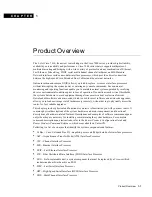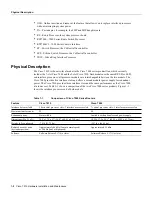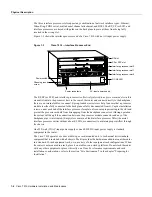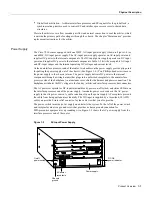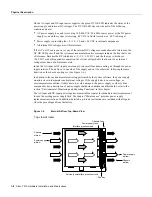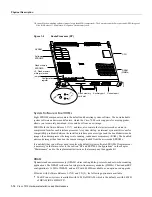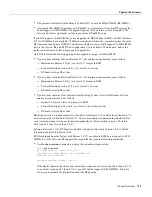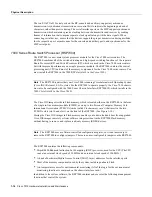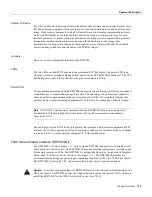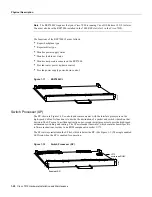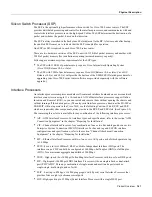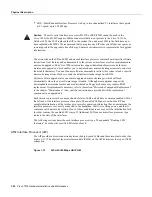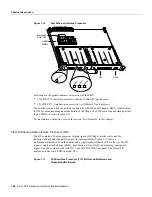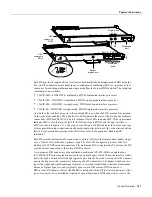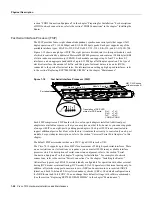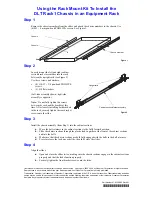
1-14 Cisco 7010 Hardware Installation and Maintenance
Physical Description
•
Use the show diag slot command to display current hardware and diagnostic information about
the processor installed in the slot you specify. Because the RP always resides in the same (RP)
slot, specify slot 4 for a Cisco 7010 chassis. The third line of the display shows the current
hardware (HW) and board revisions. (Do not confuse the HW revision with the board revision;
you need only verify that the board revision is B0 or later.)
7010# show diag 4
Slot 4:
EEPROM format version 1
Route Processor, HW rev 1.1, board revision B0
Serial number: 00809933 Part number: 73-0877-04
If the display indicates that the RP board revision is earlier than B0, your RP will not support
16-MB SIMMs. Contact a service representative for information about the RP upgrade.
NVRAM
The nonvolatile random-access memory (NVRAM) stores the system configuration and the
environmental monitoring logs, and is backed up with built-in lithium batteries that retain the
contents for a minimum of five years. When replacing an RP, be sure to back up your configuration
to a remote server so that you can retrieve it later. (See the Timesaver note that follows.)
Timesaver
Before replacing an RP, back up the running configuration to a TFTP file server so that
you can later retrieve it. If the configuration is not saved, the entire configuration will be lost—inside
the NVRAM on the removed route processor—and you will have to reenter it manually. This
procedure is not necessary if you are temporarily removing an RP you will reinstall; lithium batteries
retain the configuration in memory until you replace the RP in the system.
Flash Memory
The Cisco 7010 contains two types of Flash memory: onboard (imbedded) and on a (Flash memory)
card that can be optionally installed in a slot on the RP. The Flash memory card is required for
downloading software images larger than 4MB (compressed). Cisco IOS Release 11.0 and later
require a Flash memory card.
Either the onboard Flash memory (on a SIMM) or the Flash memory card, allows you to remotely
load and store multiple Cisco IOS and microcode images. You can download a new image over the
network or from a local server and then add the new image to Flash or replace the existing files. You
can also transfer images between Flash memory cards and the onboard 8-MB Flash memory.
You can then boot routers either manually or automatically from any of the stored images. Flash
memory also functions as a TFTP server to allow other servers to remotely boot from stored images
or to copy them into their own Flash memory.
For security of the onboard flash memory, jumper J2, which is adjacent to the imbedded Flash
memory components, provides Flash memory write protection. (See the section “Jumpers,” which
follows.)
The Flash memory card installs in the card slot on the RP faceplate. This card is an 8 or 16-MB, Intel
Series 2+ Flash memory card, which conforms with the Personal Computer Memory Card
International Association (PCMCIA) format. For more information, see the section, “Using the
Flash Memory Card” in the chapter “Installing the Router.”
Summary of Contents for TelePresence Server 7010
Page 10: ...x Cisco 7010 Hardware Installation and Maintenence ...
Page 14: ...iv Cisco 7010 Hardware Installation and Maintenance Document Conventions ...
Page 148: ...3 36 Cisco 7010 Hardware Installation and Maintenance Using the Flash Memory Card ...
Page 158: ...4 10 Cisco 7010 Hardware Installation and Maintenance Troubleshooting the Processor Subsystem ...
Page 242: ...5 84 Cisco 7010 Hardware Installation and Maintenance Replacing Internal Components ...
Page 258: ...A 16 Cisco 7010 Hardware Installation and Maintenance MIP Interface Cable Pinouts ...
Page 270: ...B 12 Cisco 7010 Hardware Installation and Maintenance Interface Processor LEDs ...
Page 274: ...C 4 Cisco 7000 Hardware Installation and Maintenance ...
Page 287: ...Index 13 ...


